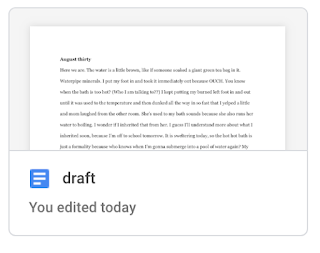Art in the time of Zoom
Here we all are, in our respective bedrooms, waiting. What a strange year 2020 is turning out to be! I, for one, am finishing up my senior year the opposite way I thought I would be, isolated in my parents’ house, watching a lot of 14-18 year olds do dances on TikTok.
Celebrating the achievements we have accomplished seems a little strange when we can’t revel in the traditions that make those achievements complete, but alas, we march on. A lot of seniors celebrated finishing their theses a few weeks ago, and I was one of them. The tradition I was hoping for was that our group of writers, groggy and exhausted, would gather to pop champagne (or more accurately, cheap prosecco) on the steps of our library. Instead, I stood in front of a zoom call and did so, with anticlimactic cheers coming from my peers over the speakers.
Regardless, I’m proud of the project I created, (You can find some excerpts here and here and here,) and in finishing it, I couldn’t help but think about what it means to be creating in our current now. Connecting to others is more valuable than ever (I’m aware that I sound like a zoom university catalogue). Coincidentally, my thesis began with the intent to create such connections. I started with the idea of writing a diary from the perspective of a young adult. I wanted to investigate the legacy of women becoming themselves in literature, and ask essentially: How do books allow women to craft their own legacies, tell their own stories, and pass down their wisdom? Based on my research in the genre, I understood that representation as a protagonist affirms the importance of female stories. This is even more powerful when the stories rebel against the thin, straight, and non promiscuous roles that women are supposed to play in society.
In addition, I decided to visually design the diary, complete with doodles, handwriting-like-font, and collages, in order to impart a feeling of tangibility. The tangible, as far as I was concerned, was another way to represent the story in a way that was almost performatively real. I think that the physical nature of a diary, the indication that someone has taken the time to create, cut and paste, draw, and write, makes the reader feel more attached to the story, and therefore less alone.
All that is to say: I wrote a book that was designed like a diary, with the intention of making people (specifically young adult women) feel less alone in their experiences.
I set out to capture the un-discussed deep loneliness that I saw occurring all around me, and hoped that my writing would offer a representation that I hadn’t yet seen in YA. Little did I know that deep loneliness would be reverberating through our world in a new way, as people sat in their homes, lives at a standstill, unable to truly feel connection during a pandemic.
Since quarantine, I’ve missed a lot of things, but the biggest losses are the small tactile moments: stealing a fry off of my roommate’s plate as they tell me about their day, flipping through my fellow thesis writers’ final drafts and smiling at the physical heft of the pages they created, sharing a beer back and forth in a grimy dorm room kitchen. Maira Kalman, in her book The Principles of Uncertainty writes about objects as “tangible evidence of history, memory. Longing, delight.” Above all, we are losing the tangible evidence of our memories and history in order to remain safe and healthy. With my project I was trying to create tangible evidence of experiences, having no idea that halfway through writing, I would be losing some of that myself.
 |
| The letters, which I keep on my bedside table. |
The times when I’ve felt comforted in quarantine have been when I’ve created memories and history despite the situation. I’ve been saving my doodles, breaking out my watercolors, and practicing my latent origami skills. I’m not trying to say that crafting is the answer to our melancholy in isolation (would you be surprised if I was though?). What I’m trying to say is, in these months where connection is based in 2D screen images, tangibility is something we should consider in a new light.
I’ve been writing letters back and forth to friends, and their handwriting and drawings comfort me just as I hoped the designs in my thesis would comfort readers. They remind me that we are connected by more than a FaceTime call, and remind me that I’m not as alone as I might feel while scrolling endlessly. Holding physical evidence of the history I am going through, combined with the intimacy that comes with a handwritten letter has also reminded me that the stories we rely are more powerful than ever before.
All that talk to say, here are some of the drafts I made for my novel. I share them in the hopes that they get you thinking about making art, writing letters, creating the way you know how, and of course, in the hopes that they remind you that isolation might mean you’re lonely, but you certainly aren’t alone.






Comments
Post a Comment